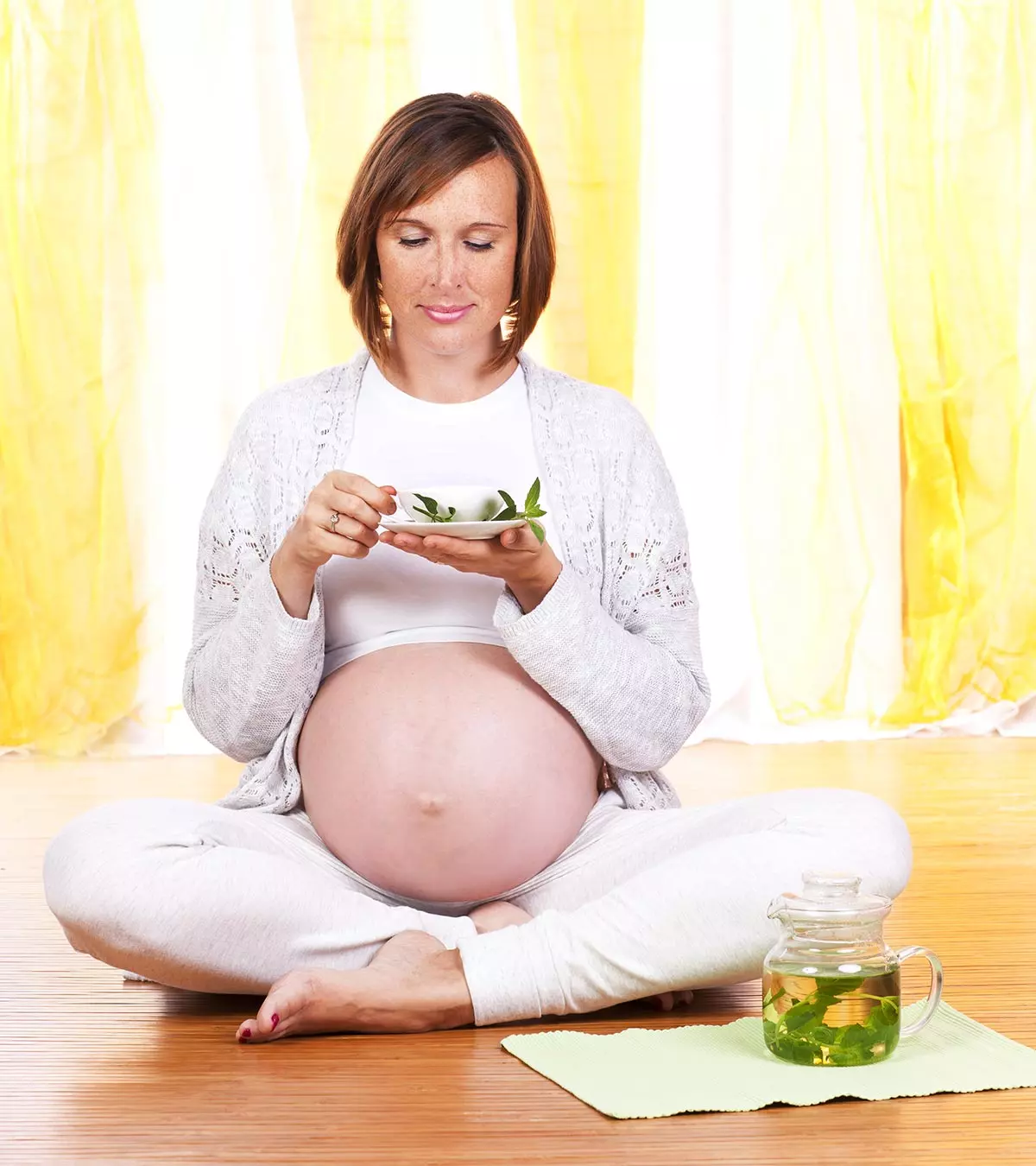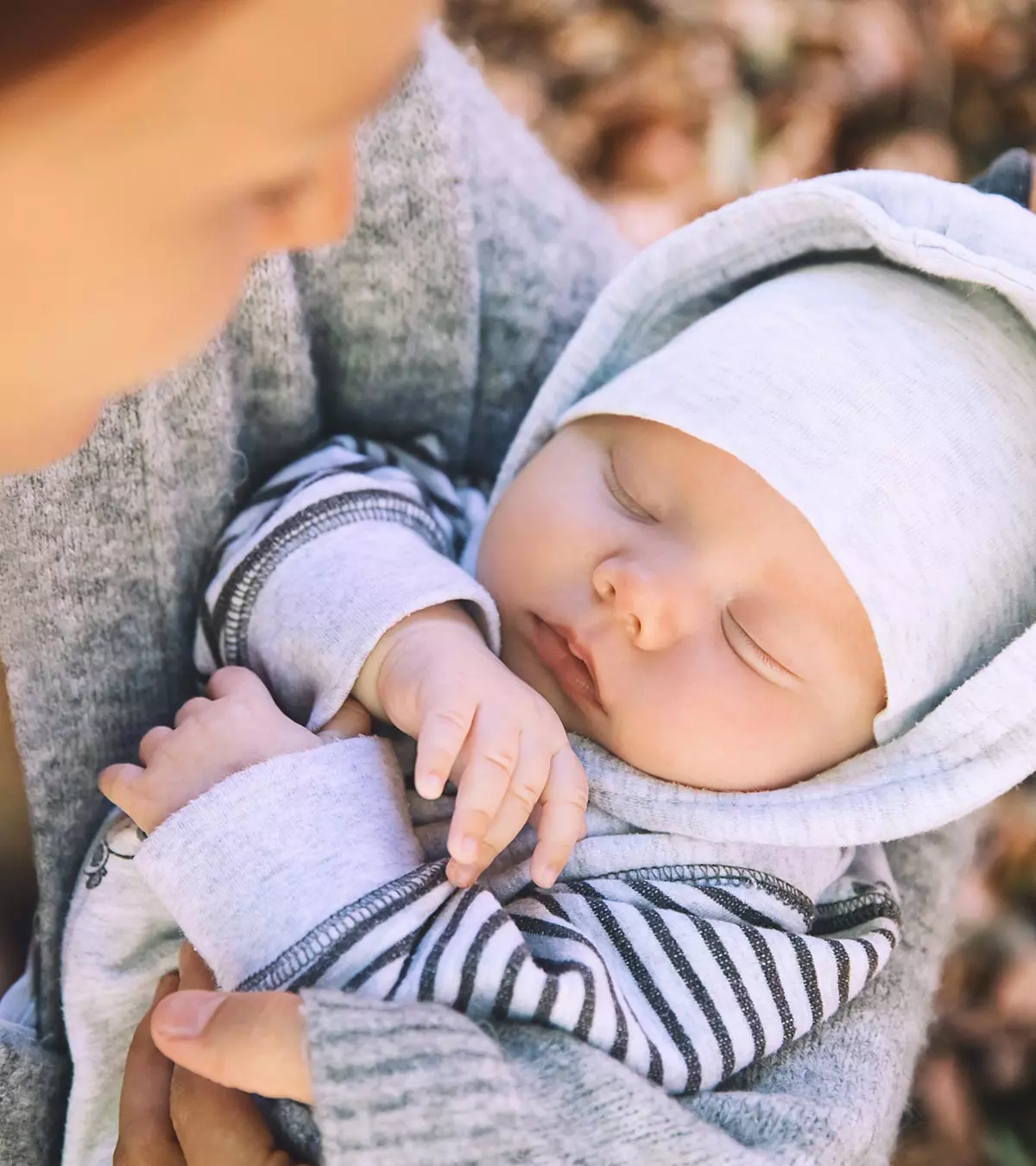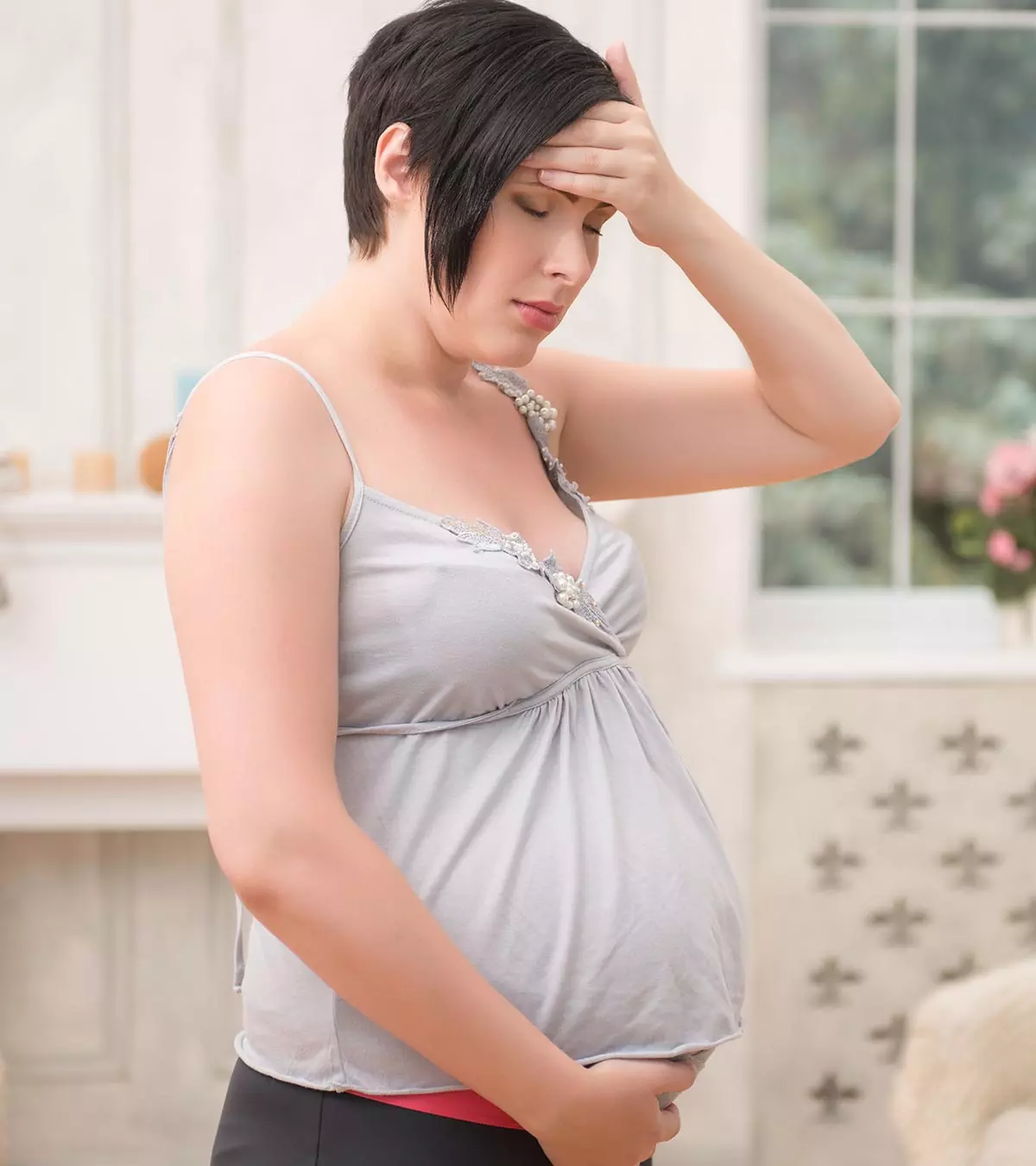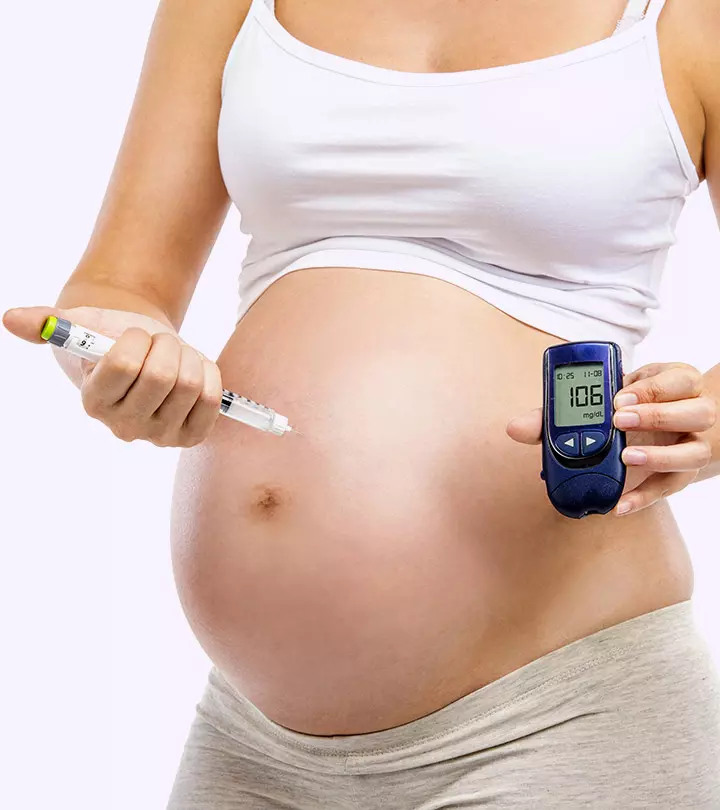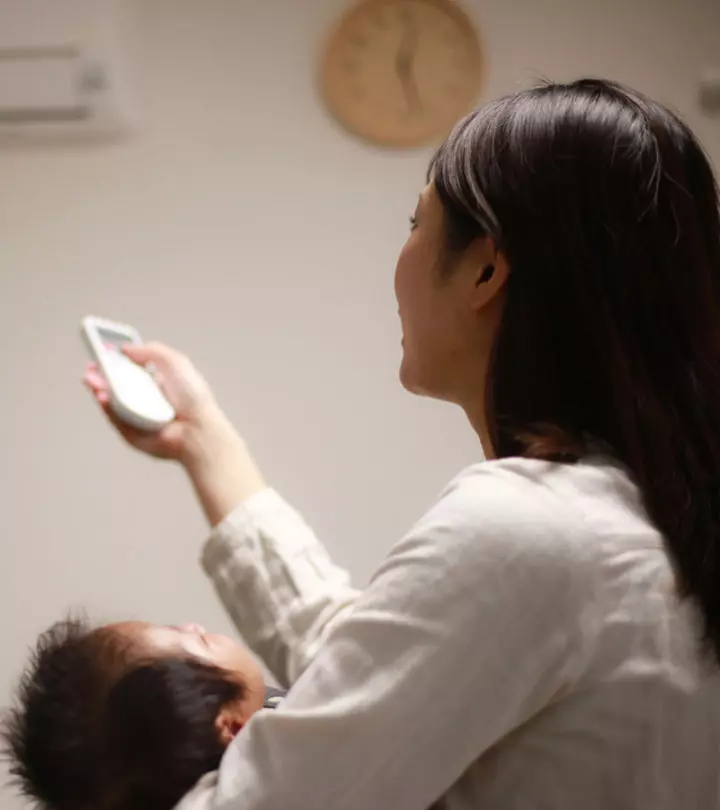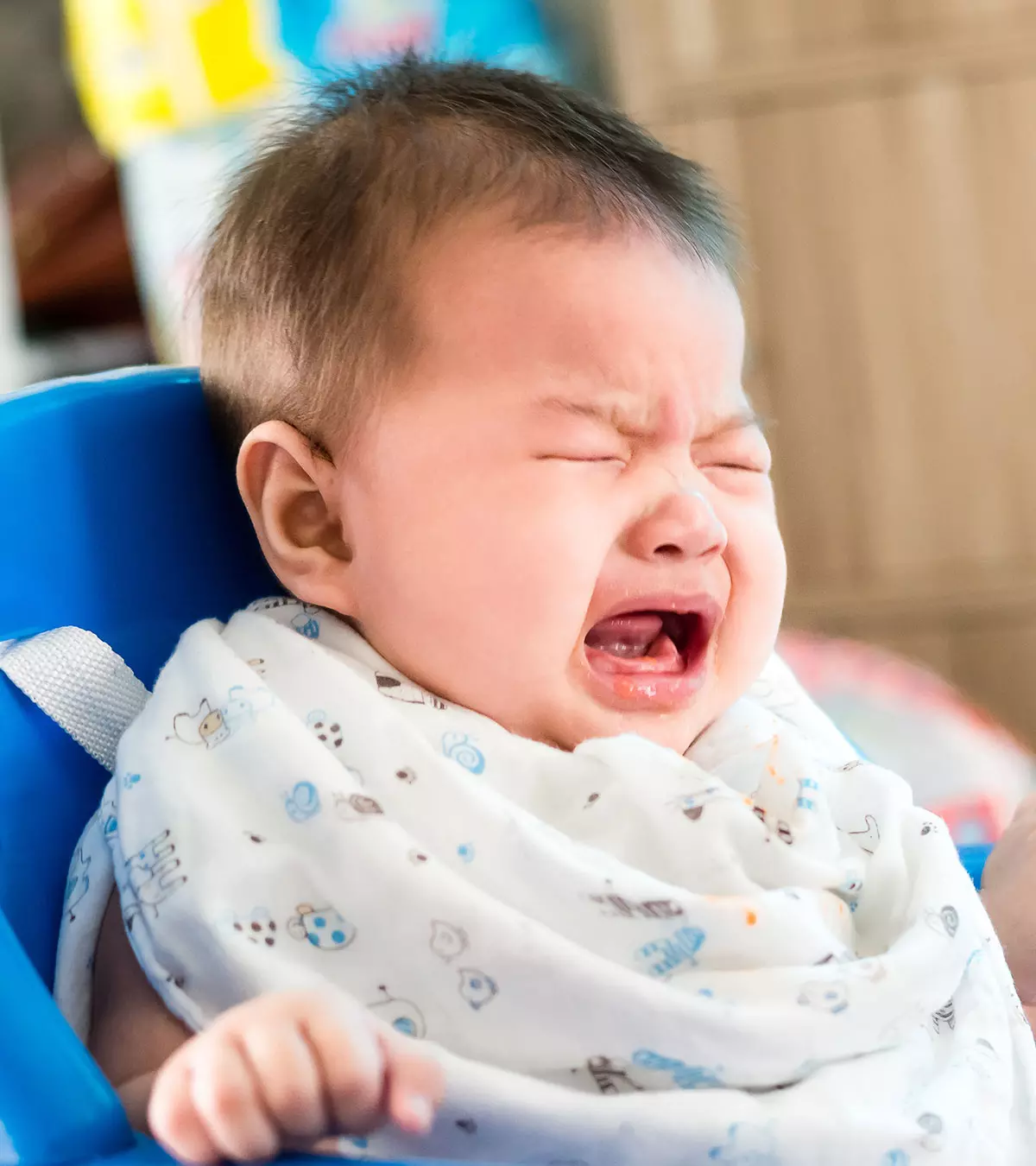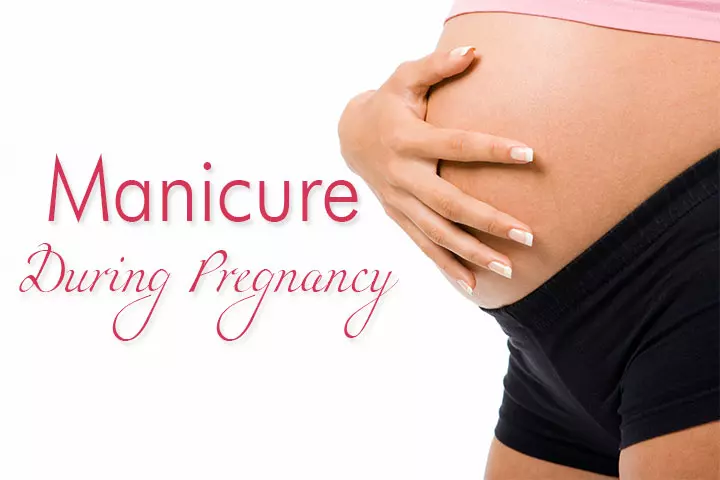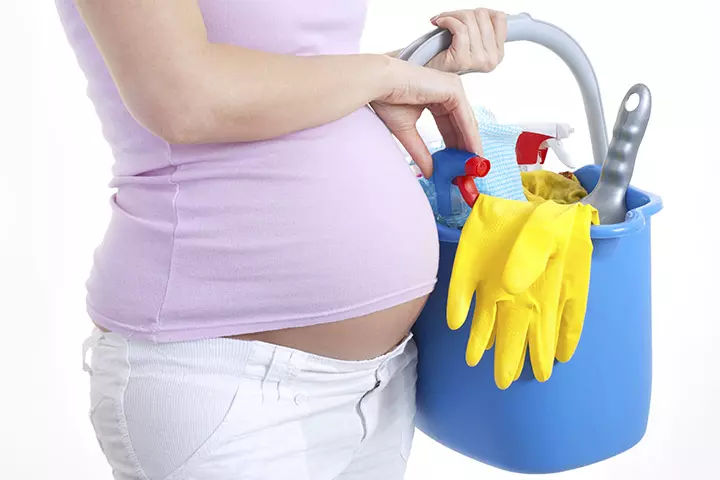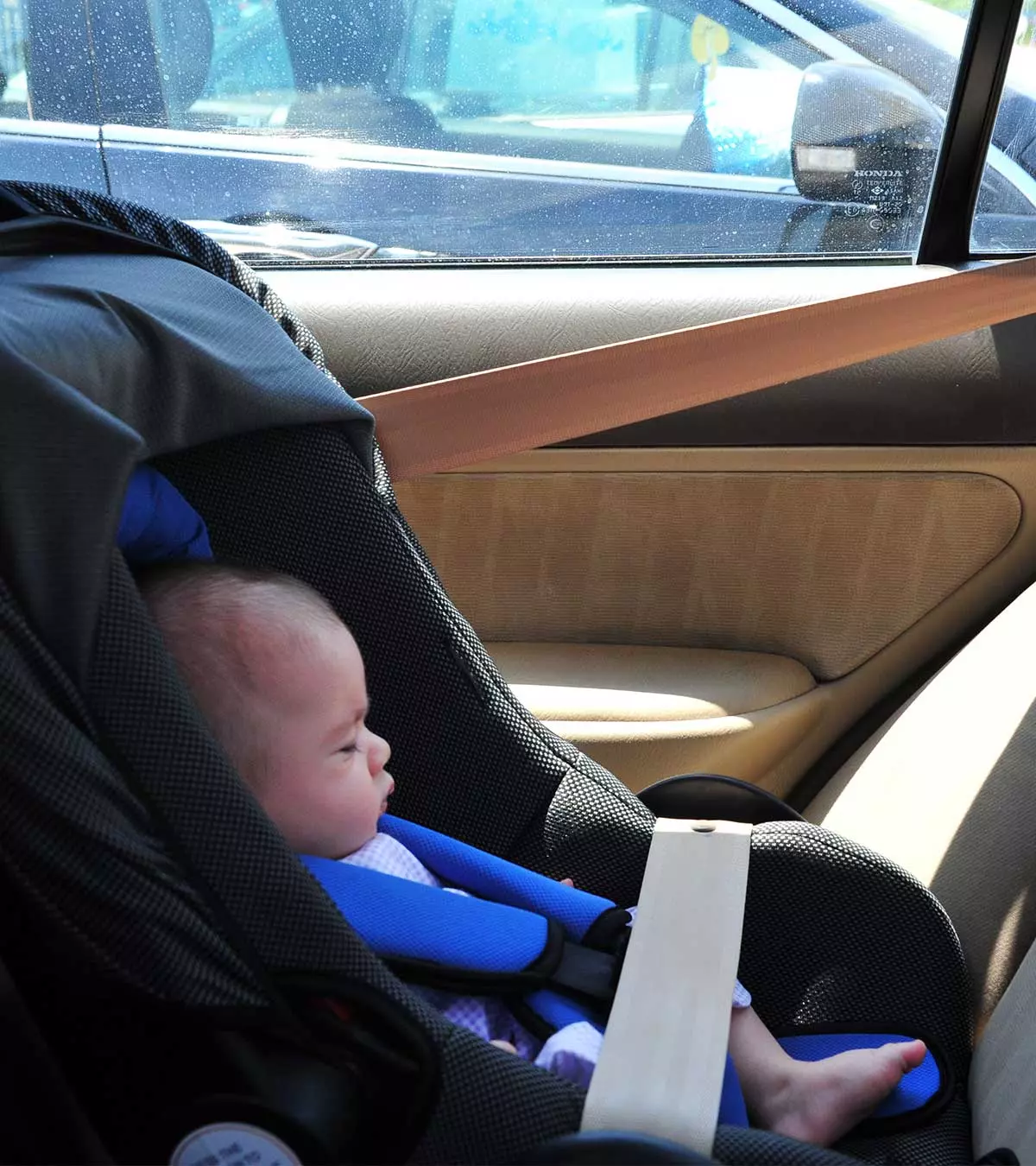
Image: Shutterstock
Babies are easily susceptible to environmental changes. For instance, a sudden temperature rise may cause heat stroke in babies. Likewise, an extremely hot day could be as difficult as wintry weather for them. Though rare, a heat stroke may cause serious consequences in babies. Therefore, you must keep a watch on your little one’s symptoms to manage the condition while it is in moderation. Read on to discover the causes, signs, treatments, and prevention of heat strokes in babies.

Key Pointers
- Heat stroke is a heat-related illness that occurs due to an increased core body temperature.
- Babies are unable to easily adjust to environmental changes and are hence more susceptible to heat strokes.
- Being left alone in a parked car, high temperature and humidity and certain medicines may contribute to the condition.
- Fever, weakness, fussiness, hot and dry skin, and reduced urination may indicate a heat stroke in babies.
- Taking measures to bring down body temperature and maintaining hydration may help treat a heat stroke.
- If the home care measures are not effective, the baby needs immediate medical attention.
What Is A Heat Stroke?
A heat stroke or sunstroke is a heat-related illness where the body is unable to dissipate heat efficiently, leading to a surge in the core body temperature(1)
. The condition is called hyperthermia in medical terms.
The body produces heat through several metabolic activities. It sheds that heat through radiation from the skin and evaporation of sweat, thus allowing the body to maintain normal temperature. However, high ambient temperatures and high humidity can prevent the body from losing sufficient heat, leading to overheating.
Evaporation does not occur when the ambient humidity exceeds 75% and is less effective in infants because they are not acclimated.
It can eventually cause a gradual rise in body temperature to more than 104°F (40°C), resulting in a heat stroke. Sometimes, the temperature can dangerously reach 106°F (41.1°C). Temperatures exceeding 106°F or 41.1°C generally are catastrophic and require immediate aggressive therapy (2).
Is Heat Stroke Same As Heat Exhaustion And Heat Cramps?
No. It is different although heat stroke, heat exhaustion, and heat cramps are all heat-related illnesses. The following are the key differences between them (3) (4):
| Heat cramps | Heat exhaustion | Heat stroke |
|---|---|---|
| A mild heat illness | Heat illness with moderate symptoms | A severe form of heat illness |
| No fever | Fever of about 100-102°F (37.8 – 39°C) | Fever of about 105°F (40.5°C) |
| The baby is conscious and healthy | The baby may feel drowsy and dizzy | The baby may be semi-conscious with extreme lethargy |
| Does not require hospitalization | Hospitalization rarely needed | Usually requires hospitalization |
| Treatable at home by drinking more fluids | Treatable at home with more fluids and rest | Will need medical attention beyond fluids and rest |
| Will last only for a few hours | May last for a few hours to a day | Effects can last from hours to several days |
| Never fatal | Seldom fatal | Very fatal; can even cause death if ignored |
 Quick fact
Quick factWhat Causes Heat Stroke In Babies?
When parents think of heat stroke, they think of summer. But the reasons for heat stroke go beyond the summer heat. Here are the things that can cause your baby to suffer heat stroke:
- Being left alone in a parked car: Leaving a child inside a stationary car with rolled up windows and no air conditioner can cause the vehicle to heat up from inside thus leading to a heat stroke in the child. In fact, heat stroke is the leading non-accident related cause of deaths for children inside an automobile. The temperature in a closed car cabin can rise quickly to as much as 20 degrees higher than the surroundings (5). Moreover, a child’s body temperature can increase about five times faster than that of an adult. These factors cause the baby to get overheated and suffer a heat stroke.
According to the Department of Meteorology and Climate Science, over half of the child mortality cases related to vehicular heat stroke in the United States occur in children under two years. Children under one year are most vulnerable and comprise 31% of heat stroke fatalities.
- High temperature and humidity: If the baby is exposed to high temperatures under direct sunlight, they can be susceptible to heat stroke. High humidity impedes optimum evaporation of sweat, which is one of the primary ways of losing body heat. Sustained exposure to a hot and humid environment can increase the risk of the baby suffering a heat stroke.

- Some medications: Some drug compounds can restrict the movement of blood from the blood vessels within the body to the ones present beneath the skin where they can lose their heat through evaporation of sweat (6). Most medicines are not meant for infants, but some of them like laxatives, antihistamines, and beta blockers, could be prescribed to them.
An anonymous mother shares her experience of when her baby, whom she refers to as Baby H, suffered a heat stroke. She says, “Last Sunday, H (her daughter) got a heat stroke when we ended up in a traffic jam for 15-20 minutes. Since the AC didn’t cool much in the excessive afternoon heat, she sweated profusely, but as soon as we got out of the traffic, she was fine, and we came home. Everything was normal until the next day when she had a little fever, one loose stool, and a bout of vomiting. I spoke to my pediatrician about her symptoms, and he diagnosed it as heat stroke, which could be treated by bringing down her body temperature. I gave her crocin as suggested and waited for the fever to come down… In a span of an hour, her body temperature rose from 98.6 to 103 degrees. Resting in her papa’s arms, she suddenly let her body loose. Her neck fell back, and she rolled her eyes. We could only see the white part of her eyes, and she lost consciousness. Naturally, we panicked. Not knowing what to do, we just rushed to our car to take her to the nearest hospital… The doctor said what she suffered was ‘febrile convulsion’ – a seizure caused due to high body temperature… However, the doctors kept her under observation for 24 hours to avoid repeated convulsions and administer medication (i).’’
What Are The Symptoms Of Heat Stroke In Babies?
A baby experiencing a heat stroke will display the following symptoms (7) (8):
- Fever with a temperature of about 105°F (40.5°C).
- Hot and dry skin. The baby may not be sweating as about 50% of children who suffer heat stroke do not sweat at all.
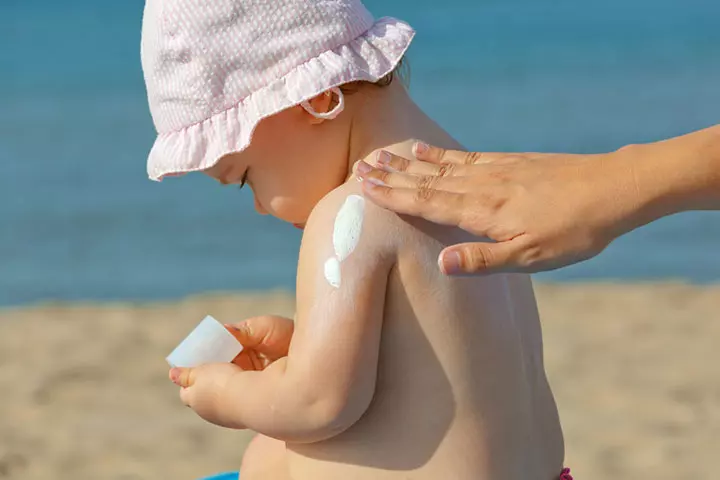
The symptoms do not emerge suddenly but develop gradually over an hour or several hours depending on the intensity of the cause of the heat stroke. Heat stroke is a medical emergency, and you must act fast.
 Be watchful
Be watchfulWhat To Do When A Baby Has A Heat Stroke?
When your baby is having a heat stroke, follow these quick home remedies:
- Move the baby to a cool place: If the baby is in the car, take them indoors to a cooler environment. Removing the baby from the hot environment is the first step in letting the baby’s body cool down.
- Remove excess clothing like a jacket: You can let the baby stay in a diaper to allow the body to cool down better.
- Spray cool water and then fan the skin: The water should be cool and not cold or ice-cold. The ideal temperature of the water is 59°F (15°C). Use a spray bottle to spray a fine mist of water on the baby’s skin and then fan it. It can help in quick loss of heat at a rate of almost 0.56°F (0.31°C) per minute.
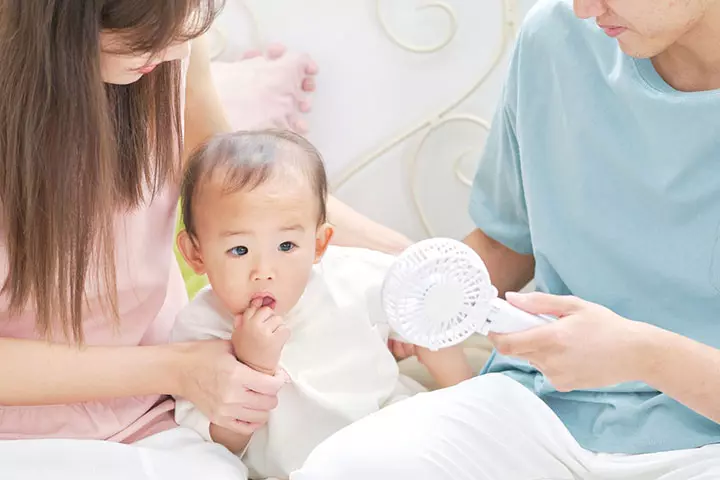
- Place ice packs at different parts: in the underarms, groin, neck, and forehead to bring down the temperature.
- Give cool fluids to drink: If your baby is younger than six months, then you can breastfeed to help the baby feel better. Infants older than six months can be breastfed and given frequent sips of cool water.
- Call a local emergency number or rush to a doctor: Your baby will also require medical attention and administration of intravenous fluids. Therefore, once you have observed the initial remedies to cool down the body temperature, call the local emergency number or take the baby to the doctor right away.
 Quick tip
Quick tipHow Is Heat Stroke Treated?
Babies diagnosed with heat stroke should be admitted to the hospital for at least 48 hours to monitor for complications
. Here is what the doctors will do beyond the home remedial steps:
- Provide intravenous fluids for hydration because heat stroke can gradually cause dehydration. The IV fluids can also help bring down the core body temperature.
- Monitor renal and neural function. The health of the baby’s kidneys and the brain are monitored continuously to ensure that these organs function properly.
- Keep the ambient temperatures low to allow the body to cool down efficiently.
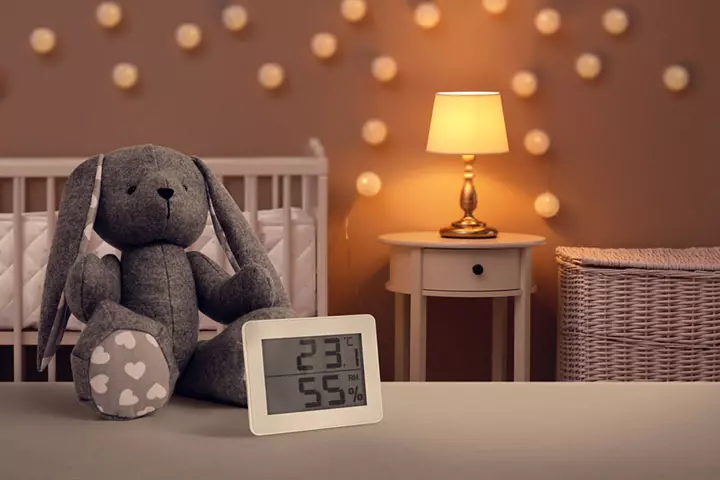
The doctors may continue using remedies like spraying cool water on the baby’s skin and placing ice packs at different parts of the body instead of giving any medications.
What Are The Complications Of Heat Stroke In Babies?
An unattended heat stroke in babies can lead to the following complications:
- Dehydration is one of the most common complications of heat stroke. A rise in temperature can cause the body to lose water and electrolytes quickly.
- High body temperature can cause the central nervous system to shut down and make the baby slip into a coma. It may also lead to convulsions and seizures in babies. In severe cases, they may sustain permanent damage to the nervous system.
- Multiple organ failure or brain damage can occur when timely help is not provided. It can eventually cause cardiac arrest and death.
Complications of heat stroke seldom happen if the baby is provided prompt attention. But did you know it is much easier to prevent heat stroke?
How To Prevent Heat Stroke In Babies?
You can prevent heat stroke in babies by minimizing their risk of exposure to high temperatures. Here is what you can do to avoid heat stroke in an infant:
- Do not leave a baby unattended in a car: Even if you are going out of the car for a few minutes, carry the child along with you. Some parents may leave the air conditioning on while leaving the child in the car. However, it is not safe. An older infant or toddler can fiddle with the air conditioning controls and switch it off thus leading to the risk of the car heating up. If there is absolutely no way to take the baby with you, then make sure you keep the air conditioning/climate control on and that there is another adult in the car with the baby. Use sunshades on windows to block direct sunlight and reduce heat build-up in the car.
- Minimize the exposure to intense sunlight: Children below the age of six months should not be exposed to direct sunlight (9). In the case of older infants and toddlers, avoid taking them out under direct sunlight between 10am and 4pm when the rays are the most intense, especially in the summer months. When going out of the house during hot weather, keep the baby hydrated by giving them frequent breastfeeds and sips of cool water.
- Dress the baby appropriately: Make the baby wear breathable, natural fabrics when going out of the home during summer months. Light-colored cotton clothes and a cotton hat will do great since they shield the baby from sunlight while also allowing ventilation to the skin and preventing overheating. During humid conditions, make sure you do not overdress the baby and if required leave the baby in a diaper for some time when it gets very hot and humid.
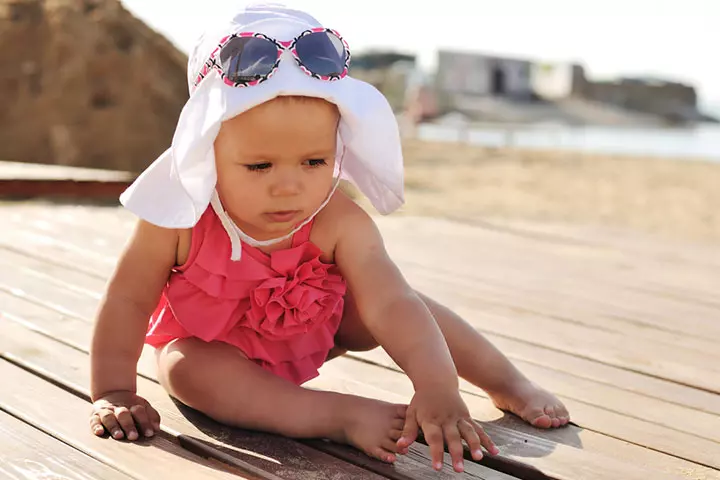
Frequently Asked Questions
1. How quickly can my baby get sunburned?
Sunburn in babies can happen easily. It is because they don’t have much melanin in their skin, which is also thin and delicate. So even if the sun isn’t shining, a baby can get burned.
Research shows many parents expose their babies to the sun’s damaging ultraviolet (UV) rays in the first six months of life when their skin is most vulnerable (10). . So care must be taken to prevent the baby from exposure to the sun’s harmful rays and prevent sunburn.
2. How long can heat stroke last in my baby?
Heat stroke subsides independently after a few hours if recognized and treated immediately. Babies diagnosed with heat stroke usually have a high fever, have hot or dry skin, and don’t sweat. To expedite the healing process, take the baby indoors, give them a cool bath, and check if they are breathing normally (11).
3. Is using a fan or air conditioner safe to keep my baby cool?
Yes. A fan or air conditioner can safely keep a baby cool. However, maintain the room temperature between 68°F (20°C) and 72°F (22°C). Avoid setting the air conditioner too low or using excessive fan speeds, as it can make the room too cold. Also, dress the baby in light, breathable clothing suitable for the temperature.
4. Are there any medications that can prevent or treat heat stroke in babies?
There are no medicines to treat or prevent heat stroke in babies. Therefore it is always better to avoid exposure to harsh sunlight and dress your baby appropriately according to the weather.
5. What are the risk factors for heat stroke in babies?
Infants and young babies are at a higher risk of heat stroke because their bodies are less adaptable to temperature changes than older children and adults. Exposure to high temperatures, excessive or inappropriate clothing for hot weather, insufficient fluid intake, and leaving the baby in confined spaces without proper ventilation are some risk factors for heat stroke in babies (12).
6. How does the body regulate temperature in babies, and how does this change as they grow?
Nonshivering thermogenesis, peripheral vasoconstriction, and heat dissipation through the skin are ways newborns and babies regulate their body temperature (13). As they grow and develop, their thermoregulatory system becomes more effective. Their sweat glands mature, producing more sweat for cooling purposes, allowing for better body temperature regulation. (14).
Heatstroke in babies is a rare but worrisome heat-related illness that can occur due to various conditions, such as exposure to high temperature and humidity and some medications. A baby diagnosed with heat stroke requires prompt medical care to avert adverse complications, such as severe dehydration, unconsciousness, and organ failure. Spraying cold water on the baby’s skin and putting ice packs wrapped in a towel or cloth at various body parts can help calm babies. Minimizing exposure to intense sunlight and dressing the baby in weather-appropriate, breathable clothes, especially in summers, can significantly reduce the heatstroke risk.
Infographic: Management And Prevention Of Heat Stroke In Babies
Exposing babies to a hot day outdoors may increase their chances of developing heat stroke. However, knowing how to manage heat stroke can help the child recover safely without complications, such as dehydration. The infographic below enlists the management and preventive tips to protect your children from heat stroke this summer. Illustration: Momjunction Design Team
Illustration: Signs Of Heat Stroke In Babies Causes And Prevention

Image: Dall·E/MomJunction Design Team
Heatstroke is a serious medical emergency. Learn how to prevent it and save a life with the following educational video.
Personal Experience: Source
MomJunction articles include first-hand experiences to provide you with better insights through real-life narratives. Here are the sources of personal accounts referenced in this article.
i. All you wanted to know about febrile convulsion: Symptoms, cure & first aid.https://mutterntochter.wordpress.com/2015/05/23/all-you-wanted-to-know-about-febrile-convulsion-symptoms-cure-treatment/#more-2356
References
1. What is heatstroke?
2. Hot cars can kill; NHTSA.
3. The difference between heat exhaustion and heatstroke; Children’s Hospital Colorado.
4. Heat exposure and reactions; Healthychildren.org
5. Preventing Heatstoke in Cars; Children’s National Hospital
6. Management of heatstroke and heat exhaustion; American Family Physician.
7. Heat exposure and reactions; Seattle Children’s Hospital
8. Heat-related illnesses in children playing sports; Children’s Hospital of Wisconsin.
9. Sun Safety: Information for Parents About Sunburn & Sunscreen; Healthychildren.org.
10. Sun-safe Babies; Skincancer.org
11. Heat exposure and reactions; Seattlechildren.org
12. Heat-Related Illness in Children in an Era of Extreme Temperatures; Stony Brook University
13. Newborn Thermoregulation; Interprofessional Education and Research Committee of the Champlain Maternal Newborn Regional Program
14. Pediatric Thermoregulation: Considerations in the Face of Global Climate Change; NCBI
Community Experiences
Join the conversation and become a part of our nurturing community! Share your stories, experiences, and insights to connect with fellow parents.
Read full bio of Dr. Fadel Husrom
Read full bio of Rohit Garoo
Read full bio of Dr. Ritika Shah
Read full bio of Vidya Tadapatri







